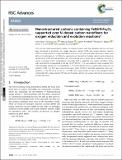Nanostructured carbons containing FeNi/NiFe2O4 supported over N-doped carbon nanofibers for oxygen reduction and evolution reactions
Abstract
Non-precious metal-based electrocatalysts on carbon materials with high durability and low cost have been developed to ameliorate the oxygen-reduction reaction (ORR) and oxygen-evolution reaction (OER) for electrochemical energy applications such as in fuel cells and water electrolysis. Herein, two different morphologies of FeNi/NiFe2O4 supported over hierarchical N-doped carbons were achieved via carbonization of the polymer nanofibers by controlling the ratio of metal salts to melamine: a mixture of carbon nanotubes (CNTs) and graphene nanotubes (GNTs) supported over carbon nanofibers (CNFs) with spherical FeNi encapsulated at the tips (G/CNT@NCNF, 1 : 3), and graphene sheets wrapped CNFs with embedded needle-like FeNi (GS@NCNF, 2 : 3). G/CNT@NCNF shows excellent ORR activity (on-set potential: 0.948 V vs. RHE) and methanol tolerance, whilst GS@NCNF exhibited significantly lower over-potential of only 230 mV at 10 mA cm-2 for OER. Such high activities are due to the synergistic effects of bimetallic NPs encapsulated at CNT tips and N-doped carbons with unique hierarchical structures and the desired defects.
Citation
Aziz , I , Lee , J G , Duran , H , Kirchhoff , K , Baker , R T , Irvine , J T S & Arshad , S N 2019 , ' Nanostructured carbons containing FeNi/NiFe 2 O 4 supported over N-doped carbon nanofibers for oxygen reduction and evolution reactions ' , RSC Advances , vol. 9 , no. 63 , pp. 36586-36599 . https://doi.org/10.1039/c9ra08053h
Publication
RSC Advances
Status
Peer reviewed
ISSN
2046-2069Type
Journal article
Description
Funding from Higher Education Commission (HEC) of Pakistan under NRPU program (grant number 4430 and 5911) is greatly acknowledged to carry out this research. Funding for Ms Iram Aziz, lead author, was provided by British Council to carry out part of this work in University of St. Andrews, UK, and by HEC under Indigenous PhD Fellowship Program.Collections
Items in the St Andrews Research Repository are protected by copyright, with all rights reserved, unless otherwise indicated.

